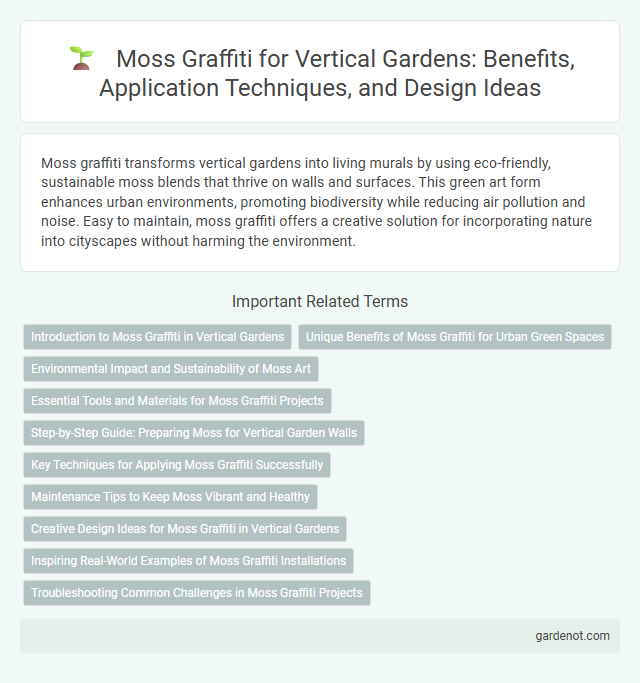Moss graffiti transforms vertical gardens into living murals by using eco-friendly, sustainable moss blends that thrive on walls and surfaces. This green art form enhances urban environments, promoting biodiversity while reducing air pollution and noise. Easy to maintain, moss graffiti offers a creative solution for incorporating nature into cityscapes without harming the environment.
Introduction to Moss Graffiti in Vertical Gardens
Moss graffiti serves as an innovative and eco-friendly element in vertical gardens, offering a natural alternative to traditional painted designs. This living art form uses moss to create vibrant, green patterns that enhance urban spaces while improving air quality and reducing heat. Incorporating moss graffiti into vertical gardens promotes biodiversity and requires minimal maintenance, making it both sustainable and visually appealing.
Unique Benefits of Moss Graffiti for Urban Green Spaces
Moss graffiti enhances urban green spaces by providing eco-friendly, low-maintenance art that improves air quality and reduces urban heat. This living art form naturally absorbs carbon dioxide and pollutants, contributing to cleaner city environments. Its ability to thrive on vertical surfaces makes moss graffiti an innovative solution for integrating nature into densely built urban areas.
Environmental Impact and Sustainability of Moss Art
Moss graffiti promotes environmental sustainability by utilizing natural, non-toxic materials that improve air quality and reduce urban heat. This eco-friendly art form requires minimal water and no harmful chemicals, supporting biodiversity within city spaces. Integrating moss art into vertical gardens enhances green infrastructure, contributing to climate change mitigation and urban ecosystem health.
Essential Tools and Materials for Moss Graffiti Projects
Essential tools and materials for moss graffiti projects include live moss varieties such as sheet moss, kieselguhr, and sphagnum moss, which serve as the primary medium for growth. A blender is necessary to mix moss with natural ingredients like buttermilk or yogurt, forming a paintable slurry that adheres to surfaces. Additional materials such as a spray bottle for application, gloves for handling, and wire mesh to support vertical structures enhance the success and longevity of moss graffiti installations.
Step-by-Step Guide: Preparing Moss for Vertical Garden Walls
Preparing moss for vertical garden walls involves selecting suitable moss species like sheet moss or cushion moss, ensuring they thrive in your climate and light conditions. Begin by blending moss fragments with a mixture of buttermilk or yogurt and water to create a spreadable slurry that encourages moss growth. Apply this mixture evenly onto the vertical surface, mist regularly to maintain moisture, and monitor humidity to promote healthy moss establishment for lush, green vertical garden walls.
Key Techniques for Applying Moss Graffiti Successfully
Creating moss graffiti requires selecting the right type of moss, typically sheet or cushion moss, and blending it with a nutrient-rich medium such as buttermilk or yogurt to help it adhere and thrive. Applying the moss mixture onto a clean, porous surface like brick or concrete ensures better moisture retention and growth, while maintaining consistent humidity and shade accelerates the moss establishment process. Regular misting and avoiding direct sunlight are crucial techniques that sustain moss health and promote vibrant, long-lasting green murals.
Maintenance Tips to Keep Moss Vibrant and Healthy
Regular misting with water ensures moss graffiti remains lush and prevents drying. Avoid direct sunlight exposure by placing the installation in shaded or partially shaded areas to maintain optimal moisture levels. Periodic application of a liquid fertilizer diluted to half strength promotes healthy growth without damaging the moss structure.
Creative Design Ideas for Moss Graffiti in Vertical Gardens
Moss graffiti transforms vertical gardens by integrating living art that thrives on damp surfaces, offering sustainable and eco-friendly design options. Creative design ideas include text-based installations for personalized messages, intricate patterns that mimic natural landscapes, and abstract shapes to enhance urban green spaces. Utilizing various moss species with different textures and shades maximizes visual contrast and promotes biodiversity within vertical garden structures.
Inspiring Real-World Examples of Moss Graffiti Installations
Moss graffiti installations transform urban spaces into living canvases, showcasing vibrant green patterns that improve air quality and aesthetic appeal. Notable examples include the work of artists like Anna Garforth, whose moss murals in London creatively integrate nature with city architecture. These installations demonstrate eco-friendly art's potential to raise environmental awareness and foster urban biodiversity.
Troubleshooting Common Challenges in Moss Graffiti Projects
Moss graffiti projects often face challenges such as uneven moss growth, drying out, and poor adhesion to surfaces, requiring consistent moisture and appropriate substrate selection for optimal results. Troubleshooting includes ensuring surfaces are porous and textured, applying a nutrient-rich moss slurry evenly, and maintaining high humidity to promote moss establishment. Addressing these issues enhances moss vitality, resulting in vibrant and sustainable vertical garden art.
Moss graffiti Infographic

 gardenot.com
gardenot.com